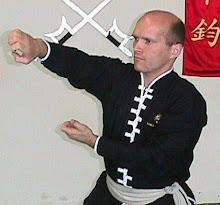One thing that I emphasize in my teaching of Eagle Claw Kung Fu is that the essence of it is to CONTROL your opponent through the use of the locks, sweeps, take-downs and other techniques that we specialize in. When people ask if I teach 'philosophy' in my class I tell them that it is but not overtly. Here is one of the main areas where that applies. For those of you who DON'T study Eagle Claw or any martial arts, this philosophy still applies!
When teaching Eagle Claw and how to use it in a fighting situation, I must make sure that the student knows how to maintain a level of calm and relaxation when they are confronted. We in Eagle Claw say that if you must fight 'keep a smile' on your face (this is one of the first things we teach in Tai Chi). Sounds funny but think of the ramifications. If you can smile when someone confronts you, they will be offset or confused by your reaction. You WILL be more relaxed- studies have shown that an 'angry face' makes people's blood pressure rise- See "Blink" by Malcolm Gladwell.
Physically, you need to be relaxed to 'catch' someone's hands or arms as we do in Eagle Claw. One way that we bring this about is to spar without gear. When a student puts boxing gloves on, they almost immediately start punching as hard as they can. Our goal is not to punch but to control (this is far more compassionate and SAFE- no broken bones or blood- to both parties) our antagonist and, thus, the situation. How can we control our opponent if we cannot control our own emotions? Ww MUST train enough to know that our technigques can and will work, have the confidence in our ability to use them and then we can stay calm. Take this out of martial arts; If you are a new driver and hit a patch of ice you painc since you haven't experienced this before. If you grew up in Minnesota you calmly turn the wheel in the proper direction and continue. Fighting and confrontational situations are similar. Self defense is also. If you have never been hit, you panic when you do and then all of your training goes out the window. When we train we do our best to go as intensly as possibly without th einjury- It is not easy but that is why training is so focused.
I ask all of my students to put this to the test by competing in full-contact fights against others in tournaments. While not actual fights (there is gear and rulse) it gets one a little taste of what it is like to have someone trying to take off their head.
In closing (I can go on a long time about this topic), if you know how to defend yourself and aren't in a state of false confidence (many schools don't test their students in a valid way) when you are confronted you will be able to remain calmer. You will not lose control of your mind set and this, in turn, will make it much easier to deescalate the situation. You may not even need to use your physical techniques- As Bruce Lee said "the art of fighting without fighting".
Subscribe to:
Post Comments (Atom)

Sifu, great points. Being an evolutionist, for me human interaction is largely nothing but a highly codified set of behaviors controlled mostly by the limbic system. In many ways, the notion of free will is an illusion. Because of this, we still act out of instinct when the flight or flight kicks in. As you say, if we act aggressive and puff our chest, this will make the other party angry and on guard as well. But, if you are calm and smiling and in control of the situation, it can go along way towards overriding that deeper animal mind and tapping into the wonderful, emergent human consciousness that will say "is this fight really worth it?".
ReplyDeleteThat's what kung fu is about for me - overriding the more 'base' reactions of our limbic system through mental discipline and reconditioned response to achieve a more controlled environment. As humans, that is what we do best - control our surroundings and use them as tools. This is what the Taoists were on about "Rule your state as if you were frying a small fish." - lightly.